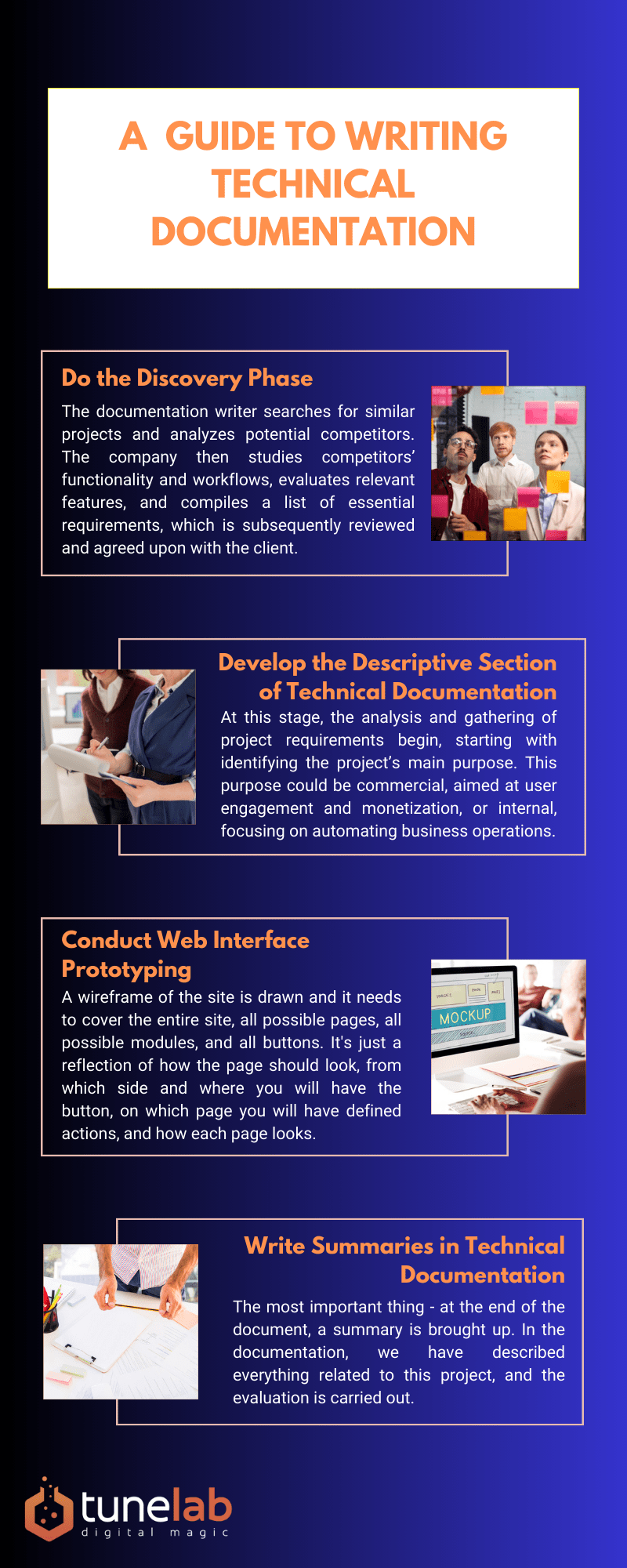Sophisticated technical documentation is a key component that determines web project success. The project’s technical documentation serves as a map that steers the team at each stage of development in the right direction while keeping all stakeholders aligned on goals, requirements, and timelines. If a client and a web development company have the documentation in their hands, then they know all the nuances of the development, as well as the pros and cons of their project.
In this blog post, we will explain the main components of technical documentation for a web project and the steps that the customer and the development company need to take to create well-thought-out and well-written documentation.
Understanding Technical Documentation
Technical documentation refers to a comprehensive set of materials that outlines each critical step involved in executing a project. It often covers aspects like project scope, planning, development phases, change management, estimates, and quality assurance measures. Well-structured documentation is crucial as it enhances communication and fosters collaboration between the client and the development team. This is why seasoned web development companies strongly encourage their clients to have project documentation in place. If a client doesn’t have it, the company often offers to create the necessary technical documentation.
A Beginner’s Guide to Technical Documentation

An Overview of the Discovery Phase
The Discovery Phase marks the beginning of the documentation process, focusing on gathering client requirements. For instance, a client might have only a rough concept for a SaaS platform to sell online courses but lacks specific details about the development and functionality. This is where the Discovery Phase becomes invaluable—during this phase, the documentation writer works to identify similar projects and analyze potential competitors. The company then studies competitors’ functionality and workflows, evaluates relevant features, and compiles a list of essential requirements, which is subsequently reviewed and agreed upon with the client.
In cases where a client seeks to automate their operations without knowing the specifics, the company needs to gather in-depth information about existing tools and workflows. However, if the client already has a clear vision for their project, the Discovery Phase is less detailed, as the client already knows what system they require. The development team then assists with specific functionalities, offers technical solutions, and suggests improvements to optimize processes. All these elements are documented for future reference.
Developing the Descriptive Section of Technical Documentation
The initial phase of documentation development involves determining if the client already has any resources such as design drafts or work descriptions. It is rare, but sometimes clients start with design and later define the project’s functionality. At this stage, the analysis and gathering of project requirements begin, starting with identifying the project’s main purpose. This purpose could be commercial, aimed at user engagement and monetization, or internal, focusing on automating business operations.
For commercial projects, integrating payment gateways and setting up subscription-based monetization is necessary. The documentation outlines user flows, evaluates requirements, and drafts an initial description that specifies the primary purpose and key features. Then, user interaction steps are mapped out. For instance, when building an e-commerce platform, the documentation covers both the administrative role of adding products for sale and the end user’s purchasing journey. User roles, actions, and the core functionality are defined in detail within the document.
After this phase, the company reconvenes with the client to review feedback and make adjustments. The client’s requirements may evolve during this time, and the development team also makes necessary revisions. Detailed specifications are recorded for all processes, from user registration to dashboard navigation. Once the descriptive section is finalized, it undergoes another round of client approval to ensure alignment with their vision before moving forward.
How Prototyping Shapes Technical Documentation
Then the prototyping of the user interface begins. A wireframe of the site is drawn and it needs to cover the entire site, all possible pages, all possible modules, and all buttons. It’s just a reflection of how the page should look, from which side and where you will have the button, on which page you will have defined actions, and how each page looks.
We usually draw wireframes in different programs. Designers do this in Figma, but it is not always required. Sometimes we may use Balsamic to create initial site layouts. This is a UI/UX drawing program where you can create a layout in a designer format. Balsamic provides a set of different elements, such as buttons, switches, the ability to create inscriptions, various icons, etc. The user receives a basic template of the page, and how it will look on the web. Creating the layout of each page according to the description is one of the most expensive steps. With the help of this program, you already draw every page of the UI.
How to Write Summaries in Technical Documentation
The most important thing – at the end of the document, a summary is brought up. In the documentation, we have described everything related to this project, and the evaluation is carried out. In general, documentation speeds up the development process and helps both sides to understand the scope of work. Because when the client has nothing, it is impossible to give them an estimate. And it is very difficult for a developer who evaluates to keep all the nuances in their head, and they must all be written. This is what documentation is needed for. Therefore, based on the results of writing the documentation, an assessment is made by the lead or CTO. The entire functionality that is written in the documentation is evaluated and written out, and the evaluation is given.
For clients who are new to web project management, the project documentation may seem to be overwhelming. However, by following the guidelines of experienced companies and all the necessary steps – from the Discovery Phase to prototyping and summary – you can create clear, organized, and professional documentation that will help the project succeed.
Professional technical documentation allows taking into account the wishes of all interested parties, professional advice from specialists, and how to create a particular project. Also, good documentation can ensure transparency and minimize the risk of miscommunication. Thoroughly written technical documentation allows for effective monitoring, better decision-making, and smoother project execution.
Using the best project management and tracking software can streamline even the most complex web projects, ensuring that all critical information is properly documented, accessible, and actionable.
Contact us if you need any help with creating project documentation or SRS ( Software Requirements Specification).


